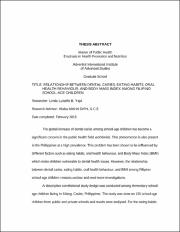| dc.description.abstract | The global increase of dental caries among school-age children has become a significant concern in the public health field worldwide. This phenomenon is also present in the Philippines at a high prevalence. This problem has been shown to be influenced by different factors such as eating habits, oral health behaviour, and Body Mass Index (BMI) which make children vulnerable to dental health issues. However, the relationship between dental caries, eating habits, oral health behaviour, and BMI among Filipino school-age children remains unclear and need more investigations.
A descriptive correlational study design was conducted among elementary school-age children living in Silang, Cavite, Philippines. The study was done on 150 school-age children from public and private schools and results were analysed. For the eating habits
of children, the overall mean of both school types (M = 80.55, SD = 9.21) showed a good eating habits among children. Looking at the eating habits of each school types, the private schools had a higher mean (M = 85.92, SD = 9.69)— good eating habits—as compared to the public schools (M = 79.48, SD = 8.89). For the oral health behaviour, the overall mean of both school types (M = 11.23, SD = 3.22) revealed a good oral health behaviour among Filipino school-age children. The means for each school types showed that the private schools had a better oral health behavior (M = 12.12, SD = 3.07) than the public schools (M = 11.05, SD = 3.24). For each school types respectively, the private schools were more overweight and obese (M = 17.88, SD = 3.62) than the public schools (M = 16.58, SD = 3.93).
Significant difference in oral health behaviour was found among female respondents while significant difference in BMI was found among male respondents. Significant difference in Decayed Missing Filled Teeth (DMFT) and BMI was found among the age group 10 to 13 years old while there was significant difference in Decayed Extracted Filled Teeth (DEFT) among the age group 6 to 8 years old. There was a statistically significant higher mean in BMI among children regarding the father/mother higher education and family income from 30,000 to 39,999 pesos and over.
The relationship between eating habits, oral health behavior, BMI, and dental caries showed a weak negative or positive correlation between variables. Significant models emerged with eating habits and oral health behavior. Urgent actions are needed to prevent and treat the current epidemic of dental caries among elementary school-age children. | en_US |

